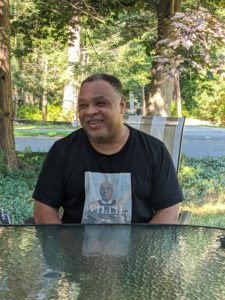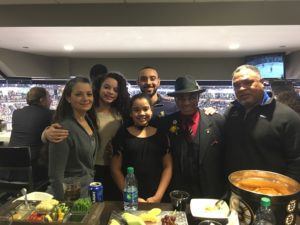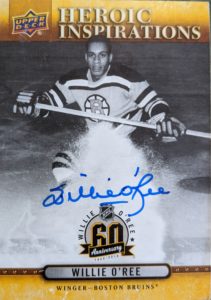
I recently had a conversation with Bryant McBride, who happens to be a neighbor of mine, and helped create the 2019 documentary, Willie, about Willie O’Ree, the first Black hockey skater in the NHL. Confession: It was easy to get this interview because I’ve known Bryant since I was a toddler; he ran the games at our neighborhood’s annual pancake breakfast. Bryant, who is Black and a former vice president of development at the NHL, helped get Willie into the NHL Hockey of Fame. We sat down for more than an hour in my front yard – socially distanced, of course, and talked about Willie, Bryant’s own career in hockey and at the NHL, and racism in America. I recently watched his film and it widened my perspective of the lack of diversity in hockey and in skating in general. Here is an excerpt from our conversation:
Me: How did you get into hockey?
Bryant: It was really where I was raised. I was born in Chicago, but then my parents moved to Sault Saint Marie in Ontario, Canada. When I was five, I was just surrounded by it. It was just part of the community, it was what everybody else did. So, I tried it, and I was like, “Oh my gosh, this is so much fun.” And I just really fell in love with the game. It’s one of those few experiences, you may see it when you are skating, where, you’re just there. You’re not thinking about homework, or anything else.
Me: How did you go from being a player to being in the NHL management?
Bryant: School. I went to good schools. Some people, when they interview for jobs, say, ‘Oh yeah, I’m a big fan.’ that’s good, but that’s not going to get you the job. What is going to get you the job is if you are a really good writer, analytically. You’re resourceful, you just figure stuff out no matter what. You know, that’s just what gets you those jobs. So, knowing about the sport, caring about the sport, knowing about all the elements in it, Definitely helps. But I did well in high school, worked really hard. And then I went to West Point, and I went to the military part of West Point, that’s hard to get into, and I established myself there. I didn’t stay there, I left, because I did not want to be in the army. So I left, but when I was there I was elected class president. I was the first Black class president at West Point. I transferred to Trinity College, and then I was lucky enough to be class president there as well. And then I got a fellowship to the University of California. And I studied there, and then I went to graduate school at Harvard, I went to the Kennedy School at Harvard. And then I worked in finance and real estate, which I really didn’t like, I found it really boring. I was like, “Eek, I want to work in sports.” And I saw that the commissioner had been hired and I got in front of him and said, ‘Hey, this is what I can do ,and I think there is an opportunity to grow this game, in unique ways.’ And he liked me, and offered me a job.

Me: And were you playing hockey all throughout this?
Bryant: I played hockey all throughout my senior year in college. So I played college hockey and did really well, we won the championship.
Me: What got you interested in increasing diversity in the NHL and what challenges did you face?
Bryant: It was really my parents. They were incredible role models and teachers. My mom used to say, ‘“If you are not part of the solution, you are part of the problem.” I took that to heart, so when I got to the NHL, I was like, “Wait, I am the first Black executive at the National Hockey League. I wasn’t hired to diversify the game, but I’m here, if I am not going to do it who is?”
Me: How did you meet Willie O’Ree?
Bryant: It took me two years to hire Willie, that was how I met him. Trying to get him to help me diversify the NHL.
Me: How did you get the idea for the documentary?
Bryant: From the woman who directed it, her name is Laurence Mathieu-Leger. About three years ago, Willie called me up, and he said, “Hey, I am going to be honored at the Boston Garden, for the 60th anniversary of my first game in the NHL, would you and your family like to come?” And I said yes. So, we went, it was a really fun night. We were talking and the commissioner, Gary Bettman, was there, and I turned to him, and I said, “We have to get Willie in the Hockey Hall of Fame.” And Gary said, “You know what, you’re right but I can’t influence that as the commissioner, but, you’re right.“ So right away I started working on it, the goal was to get Willie into the hall of fame, not to make a documentary. And then I told my neighbor, Laurence, (She is a filmmaker,) and she said, “hey we should make a documentary about this.”

Me: How can hockey and skating get more Black and brown kids into the sport?
Bryant: ‘It’s really about access and opportunity if you want to figure out how to get more people of color to skate. That’s the way I did it in hockey, just figuring out ways to break down the barriers, the barriers of equipment, the barriers of cost, the barriers of access. What I’ve found, what I’ve always found, when kids get access, they really flourish. When they don’t get opportunities, that’s when they don’t do well and they stagnate. So let’s give them the opportunities to flourish.”
Me: “Yeah, that’s kind of the interesting thing I noticed about Diversify_Ice, the organization I’m doing my website for. They’re helping Black and brown skaters skate. They’re kind of doing it in the second stage. Figure Skating of Harlem, they’re the people who are actually getting people into skating. Diversify_Ice find the kids who have the opportunity.’
Bryant: “It’s getting kids when they’re 5 or 6 years old. That’s really when you’ve got to get them. This is why skating and hockey are so important., the most important sports you can play and practice. I’ll tell you why, especially for kids of color. People will tell me, ‘what, are you kidding? We’re not welcome there.’ I’ll say, “you don’t understand.’ No one is born with skates on. It’s a great equalizer. You’ve got to figure that out.’
Bryant: What’s the first thing that happens when you get on that ice?
Me: You fall and learn to get back up.
Bryant: That one little act, you fall and get back up, you know why that’s so important?
Me: Let’s say someone says you can’t do something. You don’t just stand there and take it. You get back up and say, ‘I think I’m going to try that anyways.’
Bryant: That’s exactly right. It’s a muscle. Just like you work on that muscle to do a triple axel. You got to do it again and again and again. Constantly, that act of falling on your butt and getting back up, falling, getting back up, it’s resilience.
|
|
